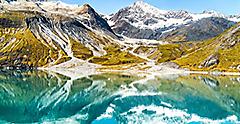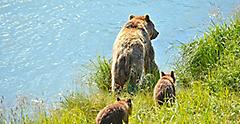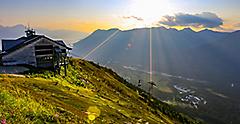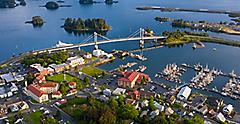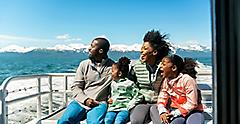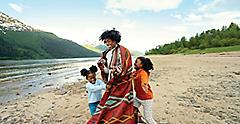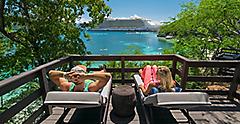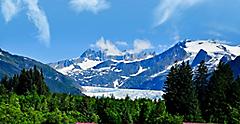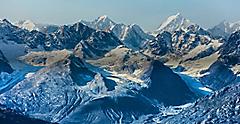What To Pack For A Cruise To Alaska
This guide provides you with packing tips to help you make the most of your Alaska vacation.
By Mary Luz Mejia | Published on January 3, 2024
Alaska's wild and rugged terrain, coupled with its ever-changing weather, makes deciding what to pack for a cruise to Alaska crucial to making the most of this epic adventure. Whether you're hiking through Denali National Park and Preserve, biking along Anchorage's Tony Knowles Coastal Trail or enjoying a day sightseeing in Juneau, this guide provides you with packing tips to help you make the most of your Alaska vacation. Read on to learn what to stash in your suitcase in order to stay warm, dry and comfortable, and how best to capture those priceless moments. Let's get packing!
Layer On The Basics
Most Alaska cruises sail from spring through to fall. The most popular months are during summer, when temperatures range from lows around 50 degrees to highs in the mid-60s to mid-70s. Whenever you choose to visit, it's a good idea to dress in layers. Even during the peak summer months, early mornings can be chilly. Include a few short-sleeved and long-sleeved shirts that you can wear under a lightweight down vest or jacket. I prefer these to a fleece because they roll up to almost nothing and are easier to tuck away in a daypack rather than a bulkier fleece, but either option will do should the mercury dip. Consider also packing a multipurpose scarf, as it can transition from an accessory to keeping you warm as a head wrap, mini blanket or even a pillow on planes and buses.
Book Now
Stay Cozy and Dry
When packing for an Alaska cruise, you'll want to bring quick-dry pants, good moisture-wicking socks in case you encounter more wet-weather conditions than you expected, and a pair of comfortable hiking shoes. You can bring hiking boots if you prefer, but boots are bulkier to pack, and hiking shoe technology has come a long way in providing style, comfort and support on uneven terrain. If the idea of spending early mornings onboard as your ship glides past majestic glaciers appeals to you, you'll want a warm hat and tech-friendly gloves, so you can still snap that perfect shot. Bring a sun hat, too, for when temperatures heat up.
Whether you are whale watching in Icy Strait Point or hiking the region's lush rainforests, a rain trench should also be on your "what to pack for Alaska" checklist. The idea is to stay warm and dry. July and August, the most popular months to see Alaska, also happen to be the state's rainiest. Preparing for quick rain showers, so you can see the sights in comfort, is recommended. For those going on a serious, full-day hike, bring rain pants for extra comfort. If you're visiting Anchorage or Juneau and want to walk around the city, a compact umbrella is a good idea, as is a lightweight waterproof bag or backpack and a phone case. Finally, if you're planning on packing casual shoes, those should have a waterproof coating, too.
Capture Special Moments
No Alaska vacation is complete without photographing some of the most beautiful places on the planet. To make this comfortable, bring a small daypack or backpack (ideally waterproof) so that you can carry your phone, camera, any special lenses you want to bring, a refillable water bottle and some snacks. Nature lovers might want to bring a compact pair of binoculars to spot breaching whales, bears and soaring eagles. A spare set of batteries is a good idea should your camera need them. Bring an extra charger as well, in case you leave one behind somewhere. This way, your phone is always ready to snap that once-in-a-lifetime memory. An extra SD card for your camera is a fine idea, too.
Think Ahead
Bring Key Personal Items
What is most important when considering what to pack for a cruise to Alaska? Whatever items are most important to you. As a result, one of the best packing tips for all vacations, but especially trips to Alaska, is to make sure you bring your favorite toiletries and all of your prescriptions with you. From shampoo and toothpaste to your toothbrush and beyond, it pays to make sure you bring items from home, as it's much more expensive to buy these things in Alaska and can eat up precious time in port.
Pack Just The Right Amount
Finally, if you're wondering how much to pack, the rule of thumb would be one top for every two days of travel and one pair of pants for every three days. Bring extra undergarments and socks in case you find yourself needing them — a rainy day can leave you with soggy socks, and changing into a fresh pair is a comforting moment. By bringing extras with you, you can spend your trip focusing on the beauty of Alaska.
Get Royal Deals, Sign Up Today
Related Articles

Cruises are the Best Birthday Weekend Getaways | Royal Caribbean Cruises
READ MORE

5 Best Weekend Getaway Ideas
READ MORE
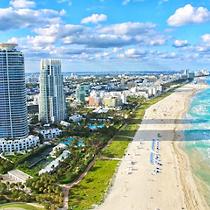
Best Weekend Cruises from Florida | Royal Caribbean Cruises
READ MORE

Top Cruise Essentials To Pack For A Weekend Getaway
READ MORE

